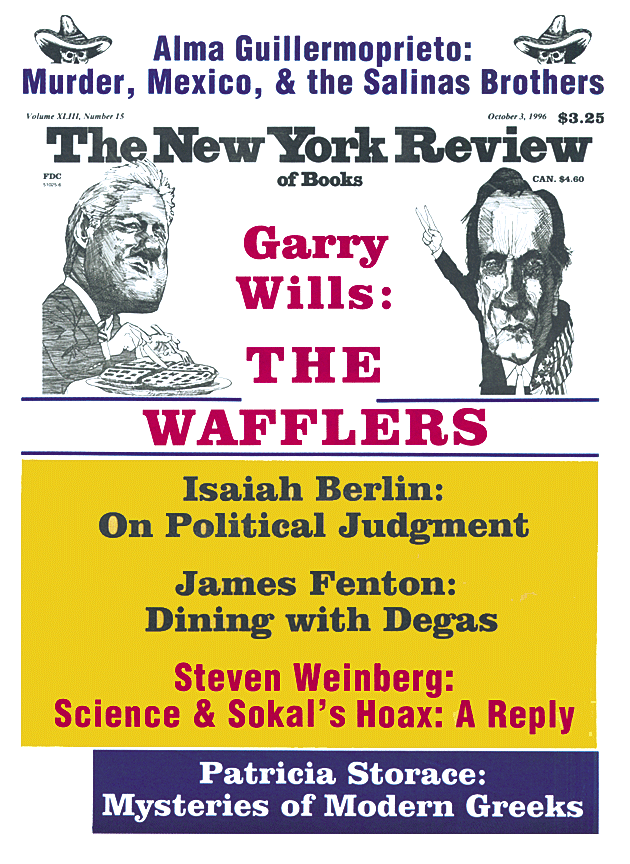In response to:
Stalin and the Jews from the July 11, 1996 issue
To the Editors:
Robert Conquest [NYR, July 11] points out the significant contribution of Kostyrchenko’s and Naumov’s books to our understanding of Stalin’s attitudes and policies toward Soviet Jews during the last decade of his rule. Although my recent War, Holocaust and Stalinism: A Documented History of the Jewish Anti-Fascist Committee in the USSR (Harwood Academic Publishers, 1995) essentially supports Conquest’s interpretation, I would like to suggest a number of corrections.
The deaths of Erlich and Alter, the two Bund leaders meant to head the stillborn Jewish Anti-Hitlerite Committee in the USSR, stirred a wave of protests in the US. The most vehement anti-Soviet statements were published in the New York Yiddish daily Forward. Articles were written and meetings convened with The Forward’s support in other American cities.
According to Mr. Conquest, the fully Soviet-controlled Jewish Anti-Fascist Committee was not exposed to anti-Semitic criticism for several years. A number of documents published in my book refute this assumption. The JAFC, established during the first months of 1942, was criticized as early as 1943. Senior apparatchiks of the Sovinformburo accused it of assuming the role of an “intermediary” between the Jewish population and the authorities, of its Zionist tendencies and its “bragging” about Jewish soldiers, scientists, and writers. These remarks corroborate the complaints about an “overproportion” of Jews in Soviet Art circulated at that time by the Central Committee Agitation and Propaganda Department. One should note that both the Sovinformburo and Central Committee anti-Semitic allegations surfaced only after the Stalingrad victory.
Mr. Conquest states that Kostyrchenko’s account of the Soviet Black Book on Nazi atrocities against Jews points to “a major link between Nazi and Soviet anti-Semitism.” The uninformed reader may assume that they were identical or at least similar. Although official as well as popular anti-Semitism was quite prevalent in wartime and postwar Russia and Stalin’s last years were marked by explicit anti-Semitic policies and anti-Jewish purges, these were still a far cry from Hitler’s Final Solution. However, if Mr. Conquest’s intention was to compare the Nazi and Stalinist “categorization” of whole populations, I tend to agree. And still, Stalin’s treatment of Kulaks seems to constitute a somewhat lower rung on the ladder of evil, compared to Hitler’s theory and practice concerning Jews. By the way, the Soviet (Russian) Black Book was published for the first time in Israel, in 1980. Most of its subsequent editions are photocopies of this edition.
Last, but not least—a word about Mr. Conquest’s remarks concerning Ukrainian-Jewish relations during the war. I wholeheartedly agree that the Ukrainians should not be viewed as a “collaborationist nation,” and that the Holocaust was first and foremost a German operation (for a discussion of whether it was an overall German or specifically Nazi phenomenon, see the current “Goldhagen controversy”). I dealt quite extensively with the case of Metropolitan Sheptytskyi’s attempts to save Jews in and around Lviv. Hilberg’s remarks on the subject, quoted by Conquest, were made more than forty years ago. Regretfully, no serious and exhaustive study of Ukrainian attitudes toward Jews in the occupied territories is available yet. Dr. Aharon Weiss, following his research based on newly emerging documentation, maintains that the leadership of the Ukrainian national movement in Western Ukraine, at least on the eve of the German invasion of the Soviet Union and during the initial phase of the occupation, adopted the Nazi approach.
Shimon Redlich
Department of History
Ben-Gurion University
Beer-Sheva, Israel
To the Editors:
Robert Conquest’s review touches on Stalin’s responsibility for the deaths of two Bundist leaders, Henryk Erlich and Viktor Alter, in 1942-1943. He mentions that David Dubinsky was the only one to organize a protest “in the face of pressure from the White House and the State Department to remain silent and not to offend the USSR.” I attended Dubinsky’s rally at the Manhattan Center and remember the occasion, with two large pictures of the victims and the unanticipated, dramatic entrance of the great Fiorello LaGuardia, who leapt onto the rostrum, eulogized the labor leaders, and ended with the unforgettable admonition: “And I say to Uncle Joe, don’t do it again.”
I seem to recall a different version of the fate of these two men, as told to me in the late 1950s by my friend and colleague Alexander Erlich, Henryk’s son: the two men had been given a laisser-passer by the Soviets in order to allow them to escape from German-occupied territory via Vladivostok to the United States. All the greater the treachery, which at the time was seen as attesting Stalin’s hatred of social democrats rather than of Jews.
Fritz Stern
University Professor of History
Columbia University
New York City
Robert Conquest replies:
Professors Redlich and Stern are to be warmly thanked for the additional information, and useful comments, they provide on Stalinist anti-Semitism and reactions to it, helpfully supplementing what I wrote.
This Issue
October 3, 1996


